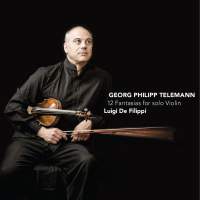Texte paru dans: / Appeared in: |
|
|
Outil de traduction ~ (Très approximatif) |
|
|
Reviewer: Barry
Brenesal These 12 fantasias were published in 1735. Telemann was already a master of a breadth of regional styles, but here, he sticks pretty closely to a mix of Austro-Italian and North German. Each contains three or four movements, with a variety of arias, recitatives fugues, dances—in short, what might almost be termed sonatas in stylus fantasticus, except that by this time, the sonata was moving strongly in the direction of the formula it would take with little variation until the 20th century. In any case, their composer wears his learning lightly in these works, spinning out short pieces that present a mix of wit, elegance, and lyricism. While Telemann’s fantasias for solo violin aren’t extremely prolific in representation of CD, they haven’t exactly lacked for performance on record, either. I pulled out two of my favorites to judge against this one: Federico Guglielmo (Brilliant Classics 94616) and Rachel Podger (Channel Classics 18298). The most obvious listening differences among the three are matters of phrasing and tempo. Podger is without exception the most lyrical in the aria-like movements. She usually takes them a bit slower than the others, warming the extra breadth with a recourse to broader dynamics. Guglielmo is a bit quicker, with a narrow but attractive tone, and concentrates upon the clear delineation of accents and figures. Filippi is slightly faster still, focusing on his rich, unpressured tone and rhythmic clarity. Guglielmo barely uses vibrato, while Podger and Filippi often do so at the end of longer phrases. In the faster, flashier movements, often emphasizing counterpoint and figures, Podger and Filippi are very similar, though she tends to accent and again apply dynamics more. (Her reading comes closest to a striking phrase I read years ago by that astute musician Roger North, who wrote about 40 years before the composition of these fantasias that musicians should “learn to fill, and soften a sound, as shades in needlework.”) Guglielmo by contrast either starts at a faster tempo, or moves to one as soon as he hits the figures: His is a more kinetic reading than either of the others. It emphasizes the virtuosic nature of this music. He also employs a larger, more reverberant aural environment which, while it doesn’t obscure his playing, removes an element of intimacy that both Podger and Filippi supply. This is all very general, but suffice to say that Podger brings out detail which Filippi either misses, or doesn’t care about—even going to the extent of improvising a drone to the slurred pairs of eighth-note figures in the fourth measure of the 12th Sonata’s finale, which emphasizes their rural fiddling quality. This isn’t to suggest that Filippi’s recording is less expressive, but that his focus is different. If I had
to choose just one among these recordings, it would be Podger. But in the
end, and with full realization that this is extremely broadly characterized,
I would suggest that Podger delights, Guglielmo thrills, and Filippi
relaxes. | |
|
|
|
|
Cliquez l'un ou l'autre
bouton pour découvrir bien d'autres critiques de CD |
|




